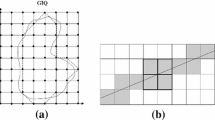Abstract
Several high-speed volume rendering methods generate spatial data structures for speedup. Although they are useful for improving rendering speed, much time may be required to regenerate them. We propose an efficient classification and rendering method that supports fast classification. While original space-leaping needs to perform distance transformations for all voxels, our method modifies the values of some parts of the entire map by assigning predefined tag values when a voxel’s transparency is changed. The rendering algorithm is an extension of the space-leaping method and it determines the next sampling position by interpreting the values of those tagged voxels. This allows us to reclassify the volume quickly and to render datasets without loss of image quality.
Similar content being viewed by others
References
Breu H, Gil J, Kirkpatrick D, Werman M (1995) Linear time Euclidean distance transform algorithms. IEEE Trans on Pattern Anal Mach Intell 17(5):529–533
Cohen D, Sheffer Z (1994) Proximity clouds – an acceleration technique for 3D grid traversal. Vis Comput 11:27–38
Crow F (1984) Summed-area tables for texture mapping. Comput Graph (SIGGRAPH ’84 Proceedings), Minneapolis, MN 18:207–212
Cuisenaire O, Macq B (1999) Fast and exact signed Euclidean distance transformation with linear complexity. IEEE International Conference on Acoustics, Speech, and Signal Processing 6:3293–3296
Cuisenaire O, Macq B (1999) Fast Euclidean morphological operators using local distance transformation by propagation, and applications. 7th International Conference on Image Processing and its Applications 2(465):856–860
Danskin J, Hanrahan P (1992) Fast algorithms for volume ray tracing. Workshop on Volume Visualization. Boston, MA, pp 91–105
Datta A, Soundaralakshmi S (2001) Fast parallel algorithm for distance transforms. The 15th International Symposium on Parallel and Distributed Processing, pp 1130–1134
Forsmoo A (1999) The distance transform algorithm on a two-processor computer. International Conference on Image Analysis and Processing, pp 114–118
Hong L, Muraki S, Kaufman A, Bartz D, He T (1997) Virtual voyage: interactive navigation in the human colon. Comput Graph (SIGGRAPH ’97 Proceedings), Los Angeles, CA 31:27–34
Hietala R, Oikarinen J (2000) A visibility determination algorithm for interactive virtual endoscopy. IEEE Visualization 2000. Salt Lake City, UT, pp 29–36
Kim T, Shin Y (2001) Fast volume rendering with interactive classification. Comput Graph 25(5):819–831
Lacroute P, Levoy M (1994) Fast volume rendering using a shear-warp factorization of the viewing transformation. Comput Graph (SIGGRAPH ’94 Proceedings), Orlando, FL, 28:451–458
Lacroute P (1995) Fast volume rendering using a shear-warp factorization of the viewing transformation. Ph.D. Dissertation, Stanford University
Lee Y, Horng S (1996) Fast parallel chessboard distance transform algorithms. International Conference on Parallel and Distributed Systems, pp 488–493
Levoy M (1988) Display of surfaces from volume data. IEEE Comput Graph Appl 8(3):29–37
Levoy M (1990) Efficient ray tracing of volume data. ACM Trans Graph 9(3):245–261
Lin H, Clapworthy G, Dong F, Krokos M, Shi J (2001) Slice-based virtual endoscopy navigation. Fifth International Conference on Information Visualization, London, England, pp 711–716
Sramek M, Kaufman A (2000) Fast ray-tracing of rectilinear volume data using distance transforms. IEEE Trans Visual Comput Graph 6(3):236–252
Subramanian K, Fussell D (1990) Applying space subdivision techniques to volume rendering. IEEE Visualization ’90. San Francisco, CA, pp 150–159
Yagel R, Kaufman A (1992) Template-based volume viewing. Comput Graph Forum (Eurographics ’92 Proceedings), Cambridge, England, pp 153–167
Yagel R, Shi Z (1993) Accelerating volume animation by space-leaping. IEEE Visualization ’93, San Jose, CA, pp 62–69
Wan M, Tang Q, Kaufman A, Liang Z, Wax M (1999) Volume rendering based interactive navigation within the human colon. IEEE Visualization ’99, San Francisco, CA, pp 397–386
Wan M, Kaufman A, Bryson S (1999) High performance presence-accelerated ray casting. IEEE Visualization ’99. San Francisco, CA, pp 379–386
Wan M, Sadiq A, Kaufman A (2002) Fast and reliable space leaping for interactive volume rendering. IEEE Visualization 2002, Boston, MA, pp 195–202
Zampirolli F, Lotufo R (2000) Classification of the distance transformation algorithms under the mathematical morphology approach. XIII Brazilian Symposium on Computer Graphics and Image Processing, Gramado, Brazil, pp 292–299
Zuiderveld K, Koning AHJ, Viergever MA (1992) Acceleration of ray casting using 3d distance transforms. Visual Biomed Comput 1808:324–335
Author information
Authors and Affiliations
Corresponding author
Rights and permissions
About this article
Cite this article
Shin, BS. An efficient classification and rendering method using tagged distance maps. Vis Comput 20, 540–553 (2004). https://doi.org/10.1007/s00371-004-0257-z
Published:
Issue Date:
DOI: https://doi.org/10.1007/s00371-004-0257-z




